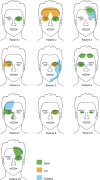Beyond coincidence: a case series on the clinical course of coinciding cluster headache and short-lasting unilateral neuralgiform headache attacks
- PMID: 40303899
- PMCID: PMC12040040
- DOI: 10.1097/PR9.0000000000001271
Beyond coincidence: a case series on the clinical course of coinciding cluster headache and short-lasting unilateral neuralgiform headache attacks
Abstract
Introduction: Limited research has been conducted on co-occurring cluster headache and short-lasting unilateral neuralgiform headache attacks (SUNHA).
Objectives: This case series aims to explore whether the observed overlap of cluster headache and SUNHA reflects a coincidental co-occurrence or suggests a shared underlying mechanism while also providing insights to improve diagnosis and management of these patients.
Methods: A retrospective case series of 10 patients with a diagnosis of both cluster headache and SUNHA.
Results: Two patients exhibited simultaneous onset of cluster headache and SUNHA (concurrent cluster-SUNHA), whereas the remaining 8 had consecutive cluster-SUNHA. Overlapping localization of pain and autonomic symptoms were observed in 9 of 10 cases. Magnetic resonance imaging was performed in 8 patients, revealing an ipsilateral trigeminal neurovascular conflict in half of them. Four patients underwent microvascular decompression, which exhibited varying efficacy on both cluster headache and SUNHA.
Conclusion: This study constitutes the most extensive description to date of individuals diagnosed with both cluster headache and SUNHA. The observed co-occurrence of these headache types could suggest a pathophysiological relationship between the 2, which might be explained by a bidirectional interaction between posterior hypothalamic function and trigeminal root demyelination. The role of a trigeminal neurovascular conflict seems likely in this context, with dedicated magnetic resonance imaging being the optimal method for its identification. The potential role of microvascular decompression as a treatment in cluster-SUNHA cases where such a conflict is identified warrants further investigation.
Keywords: Case series; Cluster headache; Microvascular decompression; SUNA; SUNCT; SUNHA.
Copyright © 2025 The Author(s). Published by Wolters Kluwer Health, Inc. on behalf of The International Association for the Study of Pain.
Conflict of interest statement
Other: MVD, microvascular decompression; NVC, neurovascular conflict; ONS, occipital nerve stimulation; TN, trigeminal neuralgia. AICA, anterior inferior cerebellar artery; CN V, trigeminal nerve; FU, follow-up; LTG, lamotrigine; MVD, microvascular decompression; Na, not assessed; NVC, neurovascular conflict; SCA, superior cerebellar artery; TN, trigeminal neuralgia; TOF, time of flight angiography.R.F. has received research support from the Netherlands Brain Foundation and ZonMw and did paid advisory work for Lilly, Takeda, Bioprojet, Jazz Pharma, Novartis, and Teva. W.M. has received research support from ZonMw. These affiliations have not influenced the content of this article.Sponsorships or competing interests that may be relevant to content are disclosed at the end of this article.
Figures


References
-
- Alberca R, Ochoa JJ. Cluster tic syndrome. Neurology 1994;44:996–9. - PubMed
-
- Benoliel R, Sharav Y, Haviv Y, Almoznino G. Tic, triggering, and tearing: from CTN to SUNHA. Headache 2017;57:997–1009. - PubMed
-
- Brandt RB, Naber WC, Ouwehand RLH, Haan J, Ferrari MD, Fronczek R. Transient side shift of cluster headache attacks after unilateral greater occipital nerve injection. Headache 2023;63:1193–7. - PubMed
-
- de Coo I, van Dijk JM, Metzemaekers JD, Haan J. A case report about cluster-tic syndrome due to venous compression of the trigeminal nerve. Headache 2017;57:654–7. - PubMed
-
- Goadsby PJ, Lipton RB. Paroxysmal hemicrania-tic syndrome. Headache 2001;41:608–9. - PubMed
LinkOut - more resources
Full Text Sources
